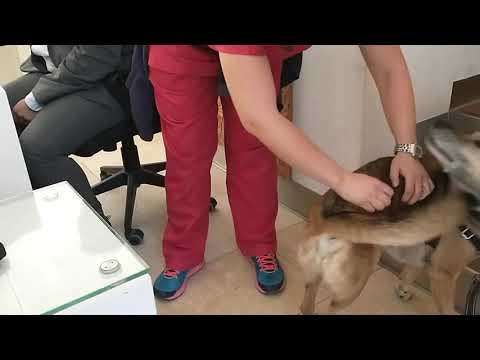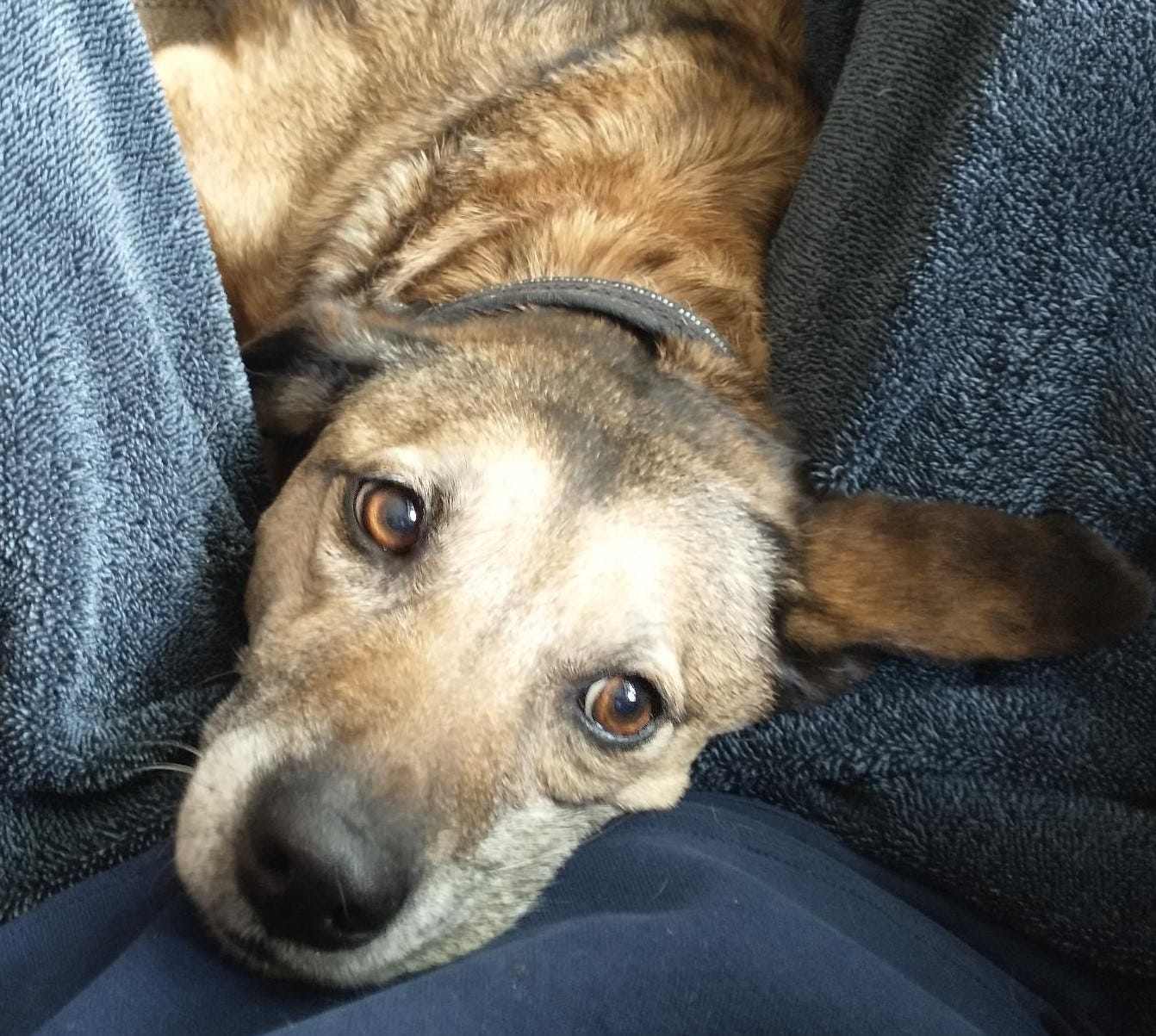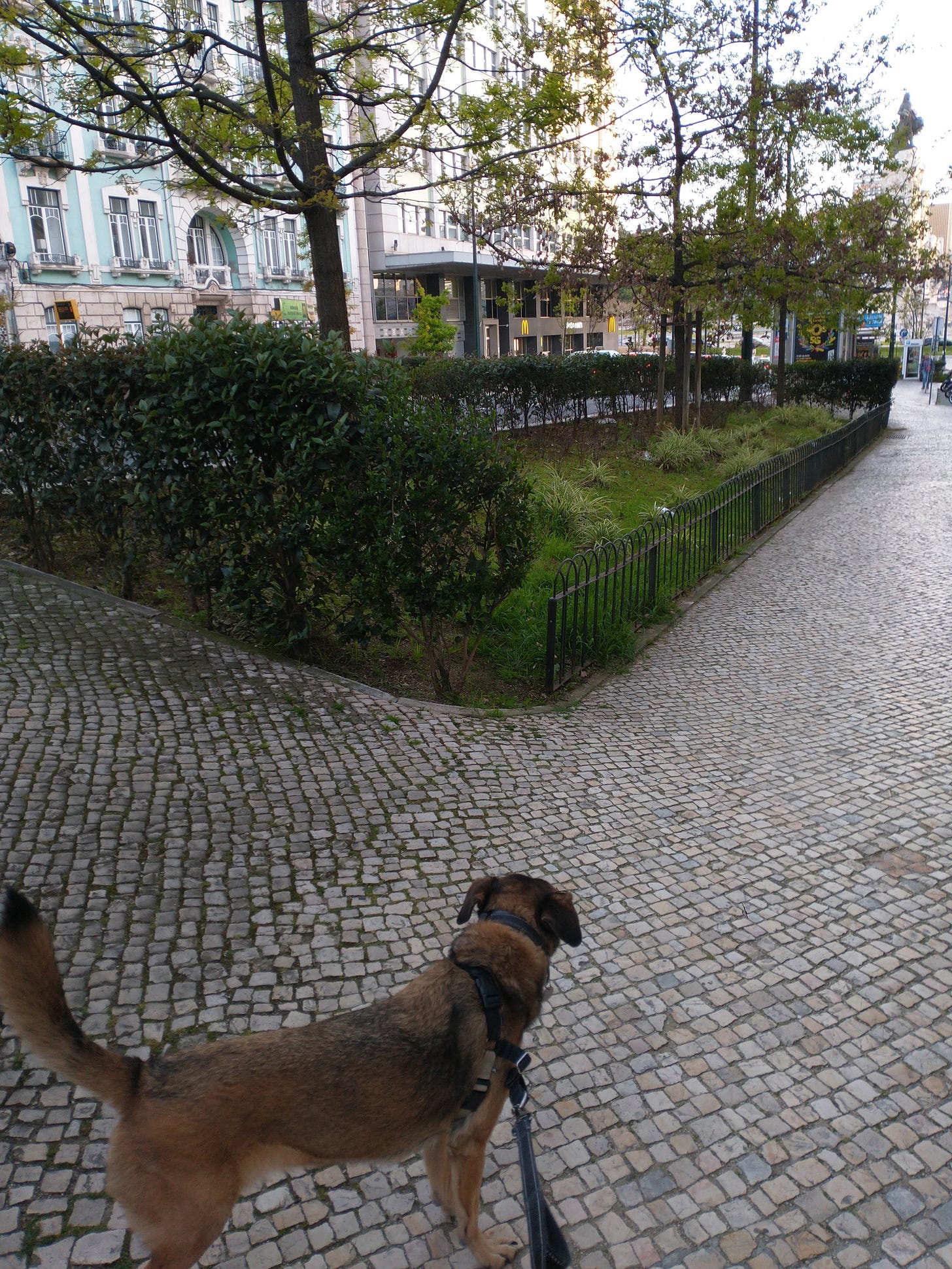Before we arrived in Lisbon, we spent hours scouring the internet and quizzing urban-dwelling friends about what life would be like for Josie:
How would she find places to go the bathroom? She’s used to grass, there’s a small patch of grass a fair distance from our apartment but taking her there three times a day would get boring very quickly.
Would the daily walking be ok?
What did we have to do to get Josie in shape for Lisbon?
How will we handle the rampant loose dogs; we hear Portugal is overrun?
Turns out, the only question we should have been asking was
Is Lisbon ready for Josie?
Here’s a brief overview of some of the more important areas of Josie’s life:
The vet
The people at Hospital Veterinário de São Bento are wonderful. It’s abundantly obvious that everyone there cares about animals. That said, it seems to be only Josie who gets this level of treatment, which happens multiple times a visit. Last month, the vet told us she’s the friendliest dog they’ve ever had. Getting from the lobby to the waiting area can take a while as folks stop to say hi. It’s no wonder she loves going. And, as we discovered a few months back, they’re open 24 hours. We’re quite relieved our new apartment is close enough that we don't need to change vets.
The reason she’s such a celebrity there is because we signed her up for a stretch of eight physiotherapy appointments to build muscle in her hips as part of her recovery from two surgeries she had in the US before we moved. Twice a week for a month she twirled her way through the facility en route to what we came to call “the spa.” There, they worked her hard, walking her for over an hour each session on an inclined underwater treadmill. We know you want to see what that looked like so:
Josie is definitely much stronger now and we are grateful to the PT team for their good work.
Interactions about town
The regulars
We generally take the same basic walking route first thing in the morning (starting around 7:30). There’s an older woman around the corner who we’ve dubbed “the woman in the Navy blue dress.” She looks for Josie each day.
Josie’s typical opening move involves sniffing the nearest hand. Most people, though, reach first to pet her on the head. This means Josie’s nose is straight up in the air as the hand goes by. There can be nose-to-hand contact. The woman in the Navy blue dress seems to be hoping for a different outcome. Scott regrets not learning Portuguese quickly enough to communicate clearly with her. It’s highly unlikely we’ll see her again after we move.
Also on the “frequent interactions” list are:
the woman (chef?) who works at the KOB across the street and takes her nightly cigarette breaks in front of our building
some of the people who work at the dialysis center around the corner
regular patients of the same center.
The passers-by
Josie is a curious dog who loves people. This combination often has her sniffing at fellow pedestrians. Eventually, someone will look down, smile, and make little kissy noises - very exciting! Sometimes they’ll even pet her, which can lead to a scene similar to the above video.
It’s not uncommon to see six or more people walking together towards us. Invariably with a group that size, one or two will make eyes at Josie, who is unusual in her reactivity to such overtures. Most dogs will ignore passers-by completely. Josie will delay the advance of an entire party as a couple of its members stop to engage with the little twirly-girly on the sidewalk.
People. Feed. Her.
Josie has reminded us of what may be the most important experiences she has had so far: On no fewer than three occasions, random people on the street have given her food.
One woman happened to have a bag of treats handy(?!) and before Scott could react, Josie was doing her Puss in Boots routine, which earned her two of whatever was on offer that day.

Another woman, standing inside the doorway to her home, asked Amy in English if she could give Josie a treat. After hearing an affirmative, a box magically appeared and a hand made multiple trips from container to mouth amidst a constant stream of “aren’t you cute” type noises directed at Josie, in Portuguese.
But the first and still most mind-blowing opening of these encounters was the Man on Avenida da Liberdade.
For those who aren’t aware, Avenida da Liberdade is modeled after the Champs-Élysées in Paris. It’s eight lanes wide with multiple, tree-lined islands separating through traffic from the vehicles with business to conduct. Lined with fancy, brand-name shops (Cartier, Gucci, Louis Vuitton …) and served by multiple Metro stations, it’s quite busy during summer’s tourist season.
There are also many benches. Benches are exciting to a short, people-loving dog as anyone sitting on a bench is both much closer to her level and better-prepared to pet short, people-loving dogs.

On The Day in Question, Josie and Amy were out for their afternoon walk and Josie was approaching the bench-sitters, many of whom were glad to say hello. Amped on the attention, Josie pranced over to a man sitting on the floor of a van parked on the one-lane section of Avenida. His legs were sticking out the side door of the vehicle and resting on the sidewalk.
He also happened to be eating his lunch.
He acknowledged her with some kissy noises and then, without a word, he broke off half of his sandwich and just handed it to our dog. Josie, playing it like this happens to her every day, kept her cool and quickly swallowed the offering. Which prompted him to produce a second one, also immediately devoured. By this time, Amy’s brain had rebounded from its initial shock and she gently encouraged dragged our happy vigorously protesting pup away before the poor man starved himself.
This was relatively early in our time here in Lisbon and all of us learned from the experience that random food was a possibility. At least one of us remains ever hopeful for a similar encounter.
Taking care of business
Our concerns about a relative lack of grass were a non-issue. Given that many of these sidewalks have doubtless been unchanged since at least the great earthquake in 1755, our guess is that the majority of individual cobblestones throughout the city of Lisbon have been peed on multiple times. There are enough smells that it’s pretty clear where she needs to be doing her business.
That said, she’s been finding her way to patches of grass more often lately and using those. There are several green islands on a stretch of sidewalk not far from our apartment. Between the island and the road, they’re walled off by a row of bushes. Between the island and the building side, a short iron fence runs the length of the spaces. A couple of weeks ago, Josie learned she can squeeze between the hedge and the fence and access the grass. More than 75% of her morning poops have been in the same spot since. Fortunately, it’s easy to lean over the fence with a bag.
Other dogs
There’s a small, black terrier type who we frequently cross paths with on our morning walk. Buddha is a year old and quite playful. Scott can’t help but egg him on; it’s so easy - a slight jig of the shoulders or shuffle of the feet sets him to play bows and sideways skittering. This is all a bit much for Josie, though, who sticks obstinately to her “food first” mentality. For a couple of days, Buddha tried a new strategy to win Josie over: he ignored her. That almost worked! Eventually, she approached him and there was a brief spate of mutual skittering. Alas, he couldn’t maintain the disinterested façade for long.
Buddha’s owner is delightful - and if she knows a word of English, she hasn’t tipped her hand. After a smiley exchange of bom dias and a comment from her that usually contains a conjugation of the verb brincar (to play), Scott responds in Caveman Portuguese with something along the lines of Josie quer comer. Sempre comida. (Josie wants to eat. Always food.) and we continue on our respective ways.
There have been a couple of loose dogs. No more than we encountered in suburban St. Louis, though. In general, those meetings have gone just fine, though one or two have escalated past the point of comfort. Just like suburban St. Louis. Unlike St. Louis, however, it can be a bit hard to communicate with the irresponsible dog owners.
Interesting observations
We’ve learned a couple of things while out and about with Josie.
First, people tend to talk to dogs in their native language. It doesn’t matter what language the person has been speaking as the dog approaches or what language(s) the dog or its owner knows, the reversion to the first language seems almost instinctual. Not caring what words come her way, Josie just beelines towards whoever is making eyes at her. Whether it’s “you’re so cute,” que linda, or something unintelligible to us, our dog is ever-willing to be appropriately feted.
The other interesting observation has to do with what we get asked about her. In the US, when we’d got to chatting, people would ask three questions about Josie, in no particular order: Name, breed, and age.1
Here, there’s an almost single-minded focus on the gender of the pet. The question can take many forms and be hard to understand, particularly when spoken as quickly as it often is. As our ears have become more attuned to Portuguese, we’ve learned to pick out some key words - rapaz/rapariga (boy/girl), menino/a (also boy/girl), and cadela (female dog)2 being the most common.3
We suspect this focus on gender has to do with the structure of the Portuguese language. As we’ve mentioned before, Portuguese nouns are gendered - like those in all romance languages. It’s impossible to talk grammatically correctly about, say, a window or a pair of pants without knowing whether these words are masculine or feminine. The Portuguese word for dog, cão, is masculine but not all dogs are male. Knowing the gender of the specific animal in front of you is important to the proper continuation of any conversation about him. Or her.4
All in all, Josie has settled in well. She doesn’t love motorcycles, particularly when the smaller ones end up on the sidewalk. And there are more sudden noises here, which can startle her. But the potential for any given walk to turn into a smorgasbord (not always a good thing) and/or a fazer festas às cadelas5 far outweighs the negatives.
That’s all for now.
Love from Lisbon,
Scott & Amy
Josie, who’s as “mutt” as they come, will turn nine on Saturday. Happy birthday, Josie!
The word cadela doesn’t seem to carry the same connotations in Portuguese as the corresponding word in English - bitch - does.
Amusingly, the Portuguese word for cinnamon, canela, is very close to the word for female dog. Many a passer-by has been told by Scott that our dog is actually a kitchen spice. After finally settling on the mnemonic that cinnamon and canela both have Ns in them and dog and cadela both have Ds, he thinks he might get it right moving forward.
We don’t think there’s a Portuguese equivalent to “it” in a context like this. It is possible to misgender a dog, but not to ungender a dog. A dog cannot be referred to as “it.” Dogs are male or female. As are windows and pairs of pants.
pet the (female) dog party







So happy Josie is doing so well. I love water therapy. We took Macs for multiple sessions to help his arthritic hips. He loved being fussed over.
When our kids are happy, so are we!
I miss her (and all of you!). I'm just happy she/you are all happy, healthy, and living the good life. Sounds like Josie adapted right away. She's such a treasure.